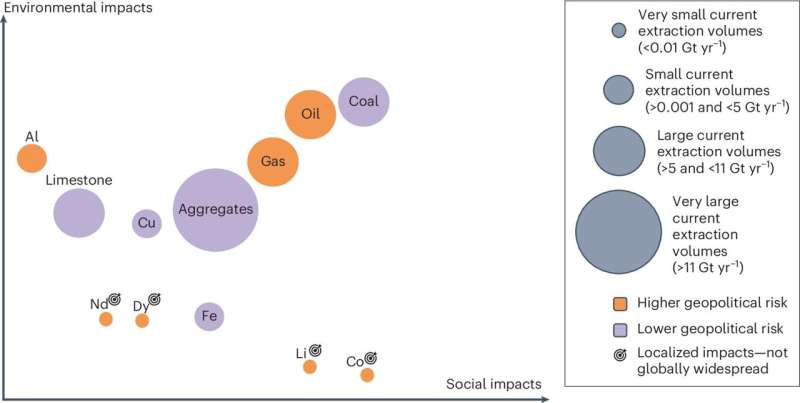This article has been reviewed according to Science X's editorial process and policies. Editors have highlighted the following attributes while ensuring the content's credibility:
fact-checked
peer-reviewed publication
proofread
Will the climate transition be a battle of materials?

As things stand today, global demand for cobalt and lithium for e-car batteries will increase almost 20-fold by 2050. By then, the development of a fossil-free power supply will require a lot of copper, aluminum and iron, and the respective demand is likely to roughly double.
Rare earth elements—essential for wind turbines, for example—will also be needed a great deal more. A new study now sheds light on the foreseeable increases in material consumption associated with the climate transition, and describes how these can be mitigated.
The study was led by the Berlin-based climate research institute MCC (Mercator Research Institute on Global Commons and Climate Change) and published in Nature Climate Change.
"It is true that decarbonization will make the global economy, as a whole, less resource-intensive than it is today by phasing out coal, oil and gas," says Felix Creutzig, head of the MCC working group Land Use, Infrastructure and Transport and lead author of the study.
"However, the additional material requirements resulting from the climate transition, the associated raw materials extraction and the waste flows pose considerable ecological and social risks at the regional and local level.
"For the first time, we systematically show that various demand-side climate solutions can be used to counteract this, including behavioral changes in mobility, housing and nutrition, and the improvement of material circularity in the economy."
So far, demand-side climate protection (as a supplement to the creation of a fossil-free energy supply) has received increasing attention primarily because of its potential for rapid greenhouse gas reduction, and because it usually goes hand in hand with increased quality of life.
The latest Assessment Report of the Intergovernmental Panel on Climate Change (IPCC) includes a separate chapter on this topic for the first time, overseen by Creutzig as a Coordinating Lead Author. The new study—a joint effort by experts from 10 countries—is the first to systematically analyze the associated potential for reduced material consumption in the climate transition.
Based on an extensive evaluation of the scientific literature, the research team first drew up a detailed risk profile for each raw material. This includes the land consumption associated with extraction, threats to biodiversity and the sometimes-enormous water requirements, health hazards caused by toxic substances or poor working conditions, as well as knock-on effects such as corruption, political instability and geopolitical dependencies.
For example, the extremely politically unstable country of Guinea is responsible for almost a quarter of the global production of the aluminum precursor bauxite. Half of the world's cobalt deposits are located in the civil-war-torn country of Congo. And 90% of semiconductor wafers for solar cells are produced in China.
Building on this risk analysis, the study then describes how demand-side climate protection can make decarbonization more material-friendly. In the transport sector, this includes more pooled mobility.
In the building sector, it is about natural construction materials, modernization of old buildings and more intensive use of living space. And in the food sector, less meat consumption means better health as well as lower material demand, for example in the reduced production of animal feed.
Overall, this is not about coercion, but about investments in infrastructure that enable people to adopt climate-friendly behaviors, as well as positive incentives to do so.
According to the study, quantifying and categorizing the potential savings in materials is now an urgent topic for further interdisciplinary research. "The Integrated Assessment Models that describe the relationships between climate policy and climate development, and ultimately form the basis for decision-making by governments via the IPCC reports, need updating," says Creutzig.
"Such models should also depict the material dimension of a low-carbon—and ultimately carbon-free—global economy. After all, the general substance of our study is that demand solutions have a doubly beneficial effect: against the climate crisis and against the plundering of the planet."
More information: Felix Creutzig et al, Demand-side strategies key for mitigating material impacts of energy transitions, Nature Climate Change (2024). DOI: 10.1038/s41558-024-02016-z
Journal information: Nature Climate Change
Provided by Mercator Research Institute on Global Commons and Climate Change (MCC) gGmbH




















